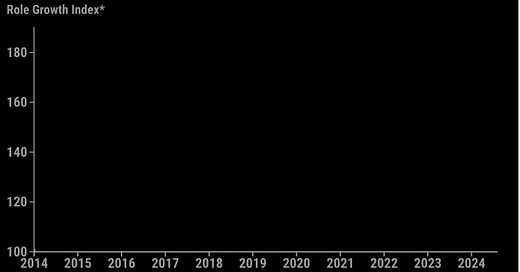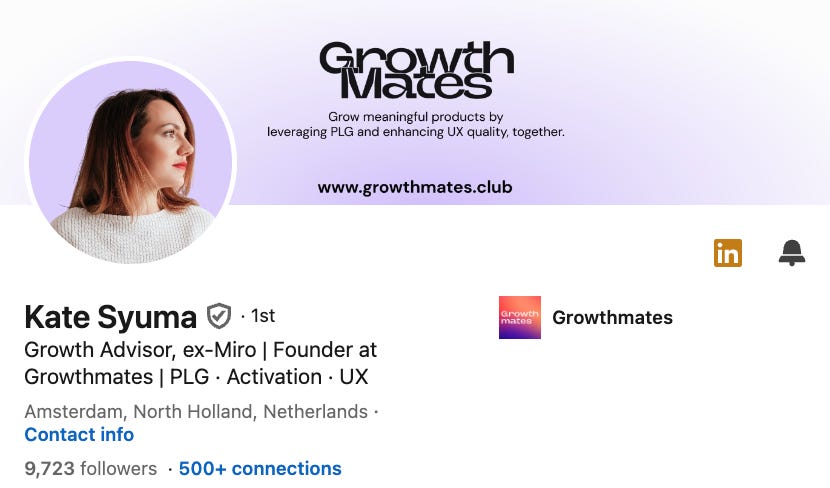The Ultimate Guide to Growth Product Design
What is growth product design, how do you set it up for success, and how should you partner with the function? Covering everything you need to know about product design's new, but growing, subfield
Growth Product Designers are the most essential counterparts to Growth Product Mangers.
Indeed, for me, no factor played a greater role in my success as a growth PM than the quality of my growth designer.
So it’s no surprise that it’s a rapidly growing role.
It’s a role that has almost doubled in the last 10 years
I worked with the fine folks at Live Data to take look at how many growth designers have been employed at various times:
Compared to 2014, there are nearly 75% more growth designers in 2024.
That’s why I've been itching to create the ultimate guide to this vital role. It's finally here.
Introducing Kate
I've teamed up with Kate Syuma, the former Head of Growth Design at Miro. Kate's journey is impressive - she started as a founding member of Miro's Growth Team and built it up to a powerhouse of 10+ Product Designers for Growth.
Now, Kate is founder of Growthmates, a platform, advising practice, and content powerhouse that's shaping the future of growth-focused product design.
Today’s Post
Words: 4,310 | Est. Reading Time: 19 mins
Today, we’re going to break down everything you need to know about Growth Product Design:
When It Makes Sense to Build a Growth Product Design Function
How to Structure a Growth Product Design Function for Success
How to Hire Bar-Raising Growth Product Designers (It’s Hard)
Grab a coffee and get comfortable, because we're about to cover a lot of ground.
1. What is Growth Product Design?
A Growth Product Designer is a (full-stack) Product designer who can design high-quality experience for user flows, connect user needs and business goals, validate hypotheses, and achieve impact on business metrics.
They don’t always need to hold that tile. They may be called Growth Designer, or Product Designer - Activation. But their core skill set is across all of UI, UX, business, and growth.
This comes out of the natural evolution of the Product Design role.
History and Evolution of Growth Product Design
Product Design is a career that has evolved relatively quickly over its short history.
There are 5 major chapters that shape the history of Product Design and led to the emergence of the Growth Product Design field we see today:
Chapter 1 - 1990s: The Emergence of UX Design
In the early 90s, as personal computers were becoming household items, Don Norman— the famous Design Author who wrote The Design of Everyday Things — was working at Apple.
But he noticed the user experience at Apple was degrading:
I realized that Apple’s great reputation for ease of use and understanding was slowly eroding.
So I proposed to my boss, the Vice President of the Advanced Product Group (ATG) that I try to do something about this. I asked two people from ATG to join me…
After considerable discussion, we named ourselves The User Experience Architect’s Office, and I took the title of Apple’s User Experience Architect.
—Don Norman
With his new title as User Experience Architect, Norman coined the term "User Experience Design.”
Norman envisioned a holistic approach to product design that considered every aspect of the user's interaction.
This was the seedling that birthed modern product design.
Chapter 2 - 2000s: The Rise of Specialized Design Roles
Over the next few decades, the tech industry boomed. And the prominence of design boomed.
But around the turn of the millennium, the field saw a growing presence of silos.
Fed up with the ‘do-it-all’ nature of the role (something PMs can relate to today), designers separated into the sub-fields of UI and UX.
This era saw the most common product design titles to be:
UI Designer
UX Designer
Interaction Designer
Designers were becoming experts in their niches, but sometimes at the cost of the bigger picture.
Chapter 3 - Early 2010s: The Age of the Product Designer
With the launch of the iPhone in 2007, a new platform was launched and new winners were crowned.
With smaller teams and tech startups starting to win again, a scrappier approach to design re-emerged. These startup designers were combining UI and UX design
Not only that, but the large companies like Apple and Google were also focusing more and more on highly usable design as a growth driver for products
So there was pressure from the bottom and very top of the market to combine the disciplines.
As a result, the titles ‘Product Design’ and ‘UI/UX Designer’ took hold, returning product design to its roots as a combined discipline.
Chapter 4 - Late 2010s: Rapid Rise of Growth Product Design
Very quickly, ‘Product Design’ became the prominent title. But Product Design naturally was too big, having merged two sub-disciplines.
So it split. But this time, it split by types of product teams. Product designers became specialized in internal tools, or core product — or, growth product.
And as the types of companies who had specialized growth product designers began to win in the market - like Slack and Dropbox - so too did the role.
From 2015 to 2020, the role grew by nearly 50%.
This was the fastest era of growth for the growth product design role.
Chapter 5 - 2020s and future: Expanding Design Horizons
In the latest chapter, product design has continued to split further.
We’ve started to see more hybrid roles started appearing that blended design with various other domains:
AI → AI Designer
UX → UX Engineer
This has meant growth product design peaked in about 2023, and now has returned to about the level it was in 2021.
This mirrors the path of PMs, with a peak in 2023 and recent retreat. Overall, both fields are roughly at their 2021 levels. As Lenny said, this is probably good for the industry. Things may have gotten a bit too excessive in the post-Covid ZIRP era.
Overall, things are looking up, and the fields of growth product and growth product design have grown tremendously from almost nothing to significant forces in the past decade.
But that doesn’t mean everything is perfect…
2. The 2 Mistaken Beliefs Hounding Growth Product Design
While the growth product design role has grown tremendously, 2 mistaken beliefs have hounded the role:
Growth designers should sacrifice quality for velocity
Growth designers are only responsible for execution
Both of these mistaken beliefs are prevalent, but neither is productive. Here’s why.
Mistaken Belief #1: Growth designers should sacrifice quality over velocity
The first mistaken belief stems from the idea that we need to think of quality and speed as a trade-off.
In product growth design, the default assumption has been to fall on the side of speed. This is a mistake.
Companies can’t be successful by compromising UX or using “unethical growth hacks”. For proof, look at what the top growth design companies do.
It’s all in their principles:

They always emphasize quality. And you feel this in their products.
Take Linear’s Invitation experience. It’s the one of the most simple and intuitive sharing experiences you’ll see:
It’s a core growth experience, it was delivered quickly, but it’s also quality. The myth that growth designers will just go fast to sacrifice quality must end.
We need both.
Mistaken Belief #2: Growth designers are only responsible for execution
It’s happened a bit on accident, growth designers being labelled as only responsible for execution.
But the thing is: Growth PMs and Growth Designers traditionally have sat on different sides of the table.
PMs sit on the business side - driving the KPIs with whatever it takes
Design sits on the user side - protecting the end-user experience with whatever it takes
This artificial siloing of each role is similar to the problems that plagued the separation of UI and UX designers. It’s splitting things that aren’t meant to be split.
In order to ship high quality to customers faster, both sides need to be connected:
PMs need to understand design (we heard Nikita Bier say something similar)
Designers need to understand business (and folks like Don Norman agree)
And that’s indeed what the best growth product teams do.
Designers are not only responsible for execution. And PMs are not only responsible for business goals.
With those mistaken beliefs out of the way, let’s get into the nitty gritty: how to build and grow a growth product design function at your company, and how to succeed as a growth product designer.
3. The 5 things that Make a Growth Product Designer
Keep reading with a 7-day free trial
Subscribe to Product Growth to keep reading this post and get 7 days of free access to the full post archives.






